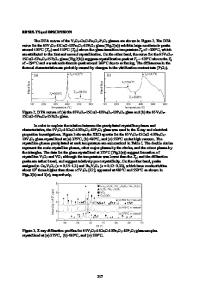Low Temperature Vitrification of Radioiodine Using AgI-Ag 2 O-P 2 O 5 Glass System
- PDF / 525,198 Bytes
- 8 Pages / 390.42 x 622.8 pts Page_size
- 69 Downloads / 290 Views
d leachability of the simulated waste glass was evaluated through parametric strength and leach tests. EXPERIMENTAL
Agl Separation Silver impregnated materials are used for the radioiodine filter of a reprocessing off-gas system, so radioiodine exists as silver iodide and silver iodate in the spent iodine adsorbent [3]. In order to vitrify radioiodine using the AgI-Ag20-P2 0 5 glass system, iodine needs to be separated as AgI from spent iodine adsorbent. A dry reducing process using hydrogen gas has been developed as a method by which radioiodine can be separated as hydrogen iodide (HI) [4]. In the present study, vacuum evaporation was examined for AgI separation, because radioiodine can be separated and collected as AgI in one step. The simulated spent adsorbent was used for AgI separation experiments. It was prepared by loading carrier gas with evaporated iodine (D.P. 33.5 0 C) at 150°C by passing through silver impregnated silica gel (AC6120-12). Then physisorbed molecular iodine was removed by purging with iodine-free nitrogen dry gas at
1500C.
An outline of the testing apparatus is shown in Fig. 2. The simulated spent adsorbent was set in the upper part of the vacuum cell and heated by cylindrical heater (1). The AgI vapor diffused downward and condensed on the surface of the vacuum cell. After that, the condensed AgI was melted by cylindrical heater (2) and collected in the bottom glass vessel. The rate of AgI separation from the simulated spent adsorbent was evaluated by changing the temperature of heater (1) and the vacuum pressure. Adsorbent was sampled at regular each time intervals during the AgI separation experiment and dissolved completely using a heated alkaline solution containing sodium thiosulfate. The iodine concentration of the dissolved solution was measured using inductively coupled plasma mass spectrometry (ICP-MS) to give the amount of iodine still in the adsorbent.
[
Heater(I)
Simulated Spent Adsorbent in Steel Basket
Spent Iodine Adsorbent
A~gISeparation
Agt Supporting Material
Ag
epartionCondensed
Agi
Iz
(Silica gel etc.)
A dditive
QuartzGlase
Heater(2)
Li 4(Silver Phosphate)Hetr) Melting • SWasteor
tVacuum Monitor of Vacuum Pressure
Fig. I Flow chart of proposed vitrification process
.
Pump
Glass Vessel
Fig. 2 Testing apparatus for vacuum evaporation of AgI
for radioiodine Preparation of Glass Specimens
AgI-Ag2 O-P2 O glass specimens were prepared from special grade reagents of silver iodide and three kinds of silver phosphates as glass formation admixtures. The specimen compositions were varied by AgI content and the molar ratio of silver to phosphorus (Ag/P) of silver phosphate, using metaphosphate at Ag/P=1, pyrophosphate at Ag/P=2 and orthophospate at AgIP=3. The
376
mixture of AgI and silver phosphate was melted in an alumina crucible placed in an electric furnace for six hours at 3S50C. During this time the melting mixture was occasionally stirred with an alumina rod. Samples for the strength test were molded in a cylindrical molder (20mm diameter and 40m
Data Loading...











